Wall World combines resource gathering and point-defense scenarios on a future Earth where the survivors of humanity have adapted to living on the side of a seemingly endless cliff face. Using multipedal mining machines called Robospiders, solitary pilots venture up and down the Wall to gather the resources that support their suspended colonies. These expeditions come under frequent attack by the Zyrex, an alien species hostile to anything they find moving on the Wall.
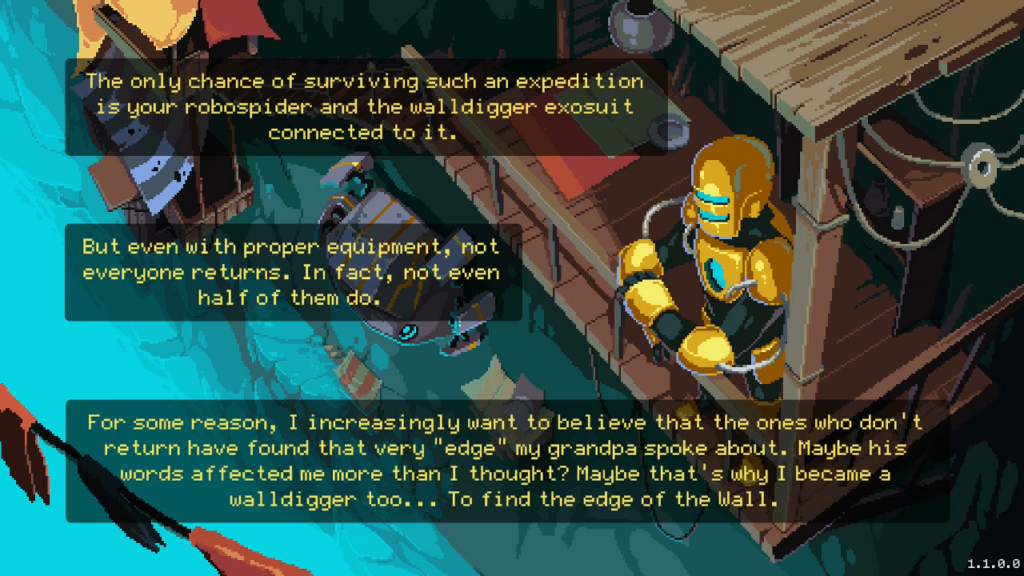
I play as one of the Robospider pilots in rounds that last for up to an hour each. Playing from a side-scrolling perspective, I guide them up and down the Wall’s surface in search of valuables while fending off periodic Zyrex attacks. Resources gathered while mining can be used to upgrade the Robospider for the current run, extending the time the pilot is able to endure the Zyrex attacks and explore the Wall. Between rounds, the player character can also upgrade their Robospider with upgrades that endure across all future attempts. The more expeditions the pilot takes, the more experience and knowledge I gain, the more durable the Robospider becomes, and the more secrets of the Wall we discover—including one which may end the Zyrex threat once and for all.
Every round of Wall World begins with the player character’s Robospider clinging to the side of the Wall. I can guide it up or down in search of disturbed earth patches on the Wall’s surface. When I maneuver the Robospider over one of these points and press a button, a laser will burst from its core and cut a hole, letting the pilot leave the pilot’s seat and enter a freshly dug mine through a hatch in the Robospider’s bottom.
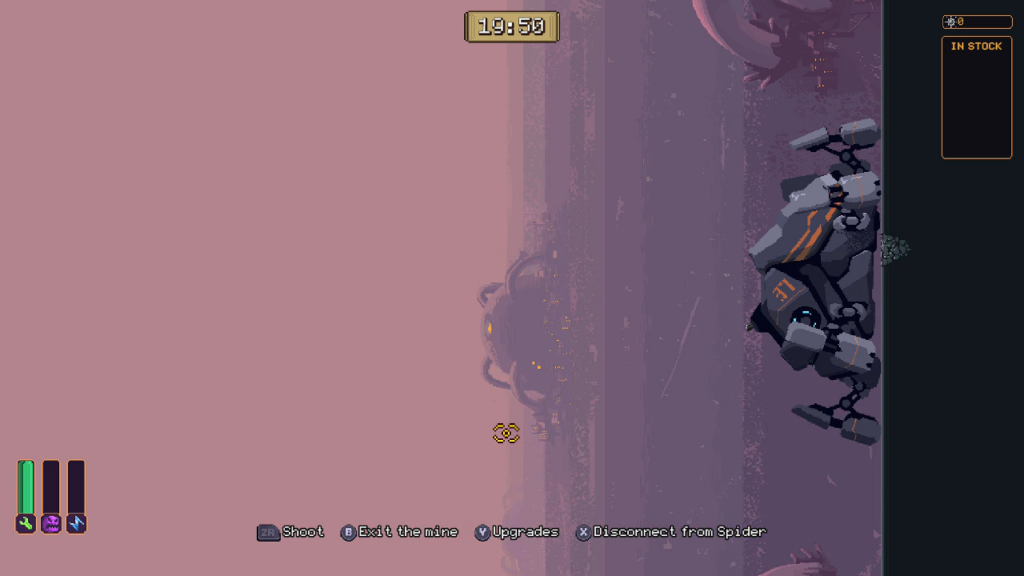
The pilot is equipped with an Exosuit, an exoskeleton fixed with repulsors that lets him float and move as though he is suspended in zero gravity, and a Plasma Drill. By holding down the right trigger button on a standard controller, I direct the pilot to fire a continuous stream of energy from the Drill, which I can point in any direction using the right joystick. This energy can cut away uniform squares of earth. Most squares are empty. Some contain precious gems whose bright colors contrast well against the empty and shadowy earthen squares. My broad goal in each individual mine is to clear away as many breakable blocks as possible to claim the rare resources they hide.
Gems scatter onto the ground when the block containing them is destroyed. The pilot can suck them up using the Plasma Drill’s vacuum function activated by the left trigger. This vacuuming feature is where I experience the most frustration with Wall World. Gems have a tendency to get sucked by the vacuum stream along the floor and straight through the player character’s legs instead of into the Drill’s storage unit. With some practice I learn approximately how to move and angle the stream to ensure gems are sucked up instead of further scattered across the mine, but it never feels as effortless as it should. Since each round’s strict time limit is always pushing against the player character, every second wasted chasing after gems hurts more than the last.
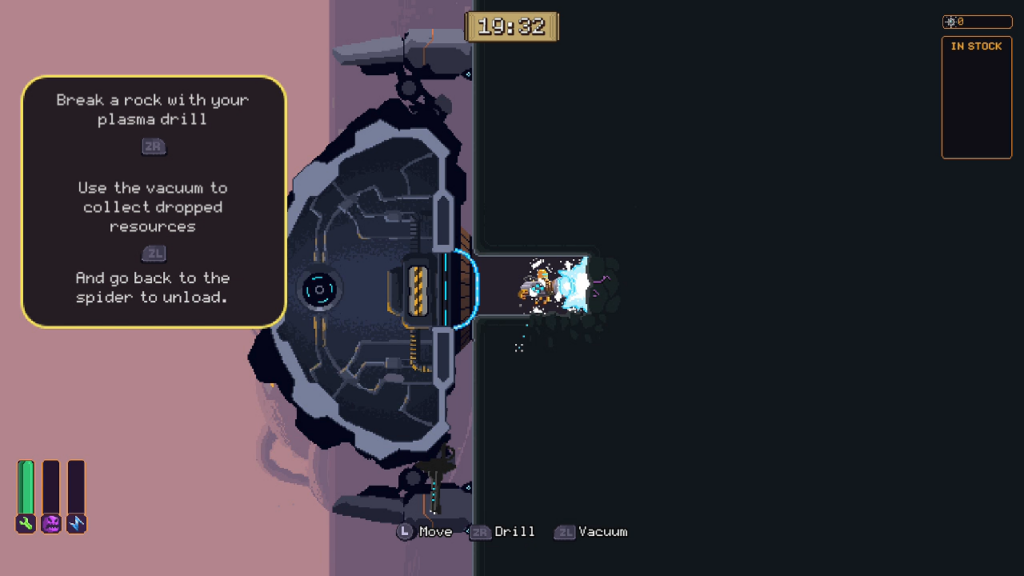
Once the player character is loaded with precious gems, I guide them back to the Robospider at the mine’s far left side where they are automatically deposited into its bottomless hold. Despite Wall World’s premise of miners who gather resources to support their colonies, there is no reason to be thrifty with the player character’s stockpiled riches. Every shiny rock they claim is used to improve the Robospider for the current run and the current run only. Anything still in the hold at a run’s end is lost.
Gems come in two categories: Common blue ones and a panoply of other colors and shapes. Blue gems are the workhorse currency and are found everywhere. Every single Robospider upgrade requires them; the better the upgrade, the more it requires, starting at as few as four and rising to as many as ninety. Upgrades require a smaller amount of specially colored gems, but there are correspondingly fewer of these to be found within the mines.
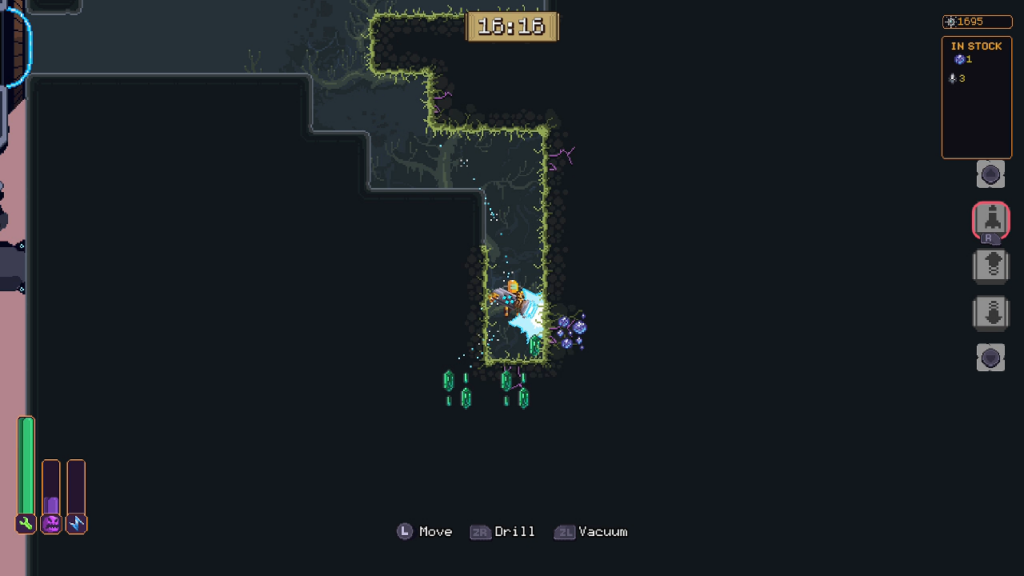
The specialized gems form the basis of a technology tree. The earliest upgrades require white crystals shaped like arrowheads. The next tier requires rough green gems. Ultimately there are seven different gems supporting the tech tree which the pilot works through in each new round.
Upgrading the Robospider is key to surviving on the Wall as the pilot travels further afield from his starting point. The most important upgrades improve the speed of the Exosuit and the effectiveness of the Plasma Drill, increasing the efficiency at which he strips mines bare of their riches. These become even more significant as the pilot travels further from the Wall’s center and mines begin to feature tougher earth. A slow pilot with a basic Drill will find themselves wasting too much of their limited time trying to burrow through tough earth and carry their spoils the long distances back to the Robospider. Gems can also be spent to upgrade the speed and power of the Robospider’s projectile weapon—but more on that in a little while.
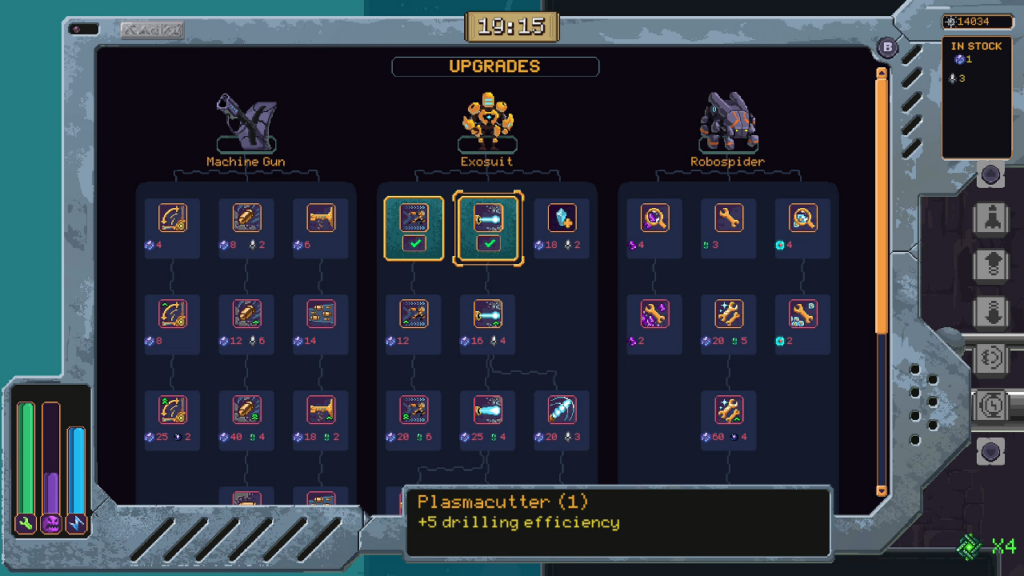
The Robospider begins every run equipped with these basic tools. New equipment can be found randomly within the mines themselves. Most come from Relics, ancient spheres found in some mines which confer new equipment when they are carried back to the Robospider. Equipment includes helpful items like a portable Docking Station, which improves the pilot’s mining tools when he remains near it, and an automated Resource Harvester that adds new blue gems to the Robospider’s hold every few minutes. In the deepest parts of large mines, the pilot can also discover Robospider wrecks which carry new weapons like shotguns, bomb launchers, laser machine guns, and railguns. Like the default equipment, all of these new tools can be upgraded using gems.
In my first few hours playing Wall World, I assume the direction I send the Robospider up or down the Wall doesn’t matter. I assume the player character will naturally come across the next tier of gems the further away from their starting point they travel. I assume the many background elements that scroll behind the Robospider as it clanks and whirs up and down the Wall are decorative and as randomly generated as the mines the player character explores. I make these assumptions because the narration in the prologue describes the Wall as continuing “infinitely in all directions.” All of these assumptions and the player character’s assertion are incorrect. The Wall is finite and its resources are scattered with intention and predictability.
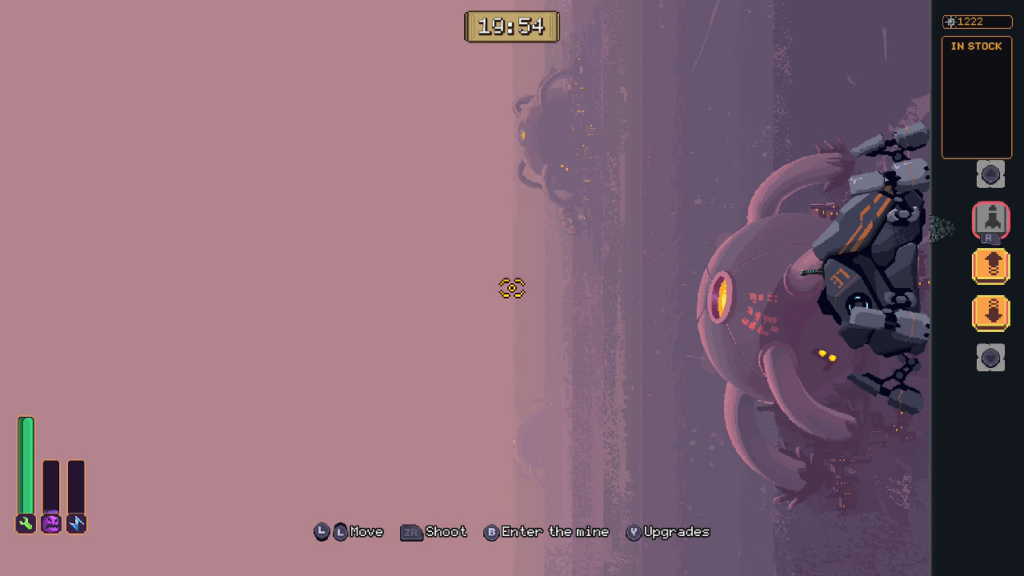
Wherever the Robospider travels I can see the Wall looming behind it, extending into an unseeable distance, covered in unique features I can use to identify where the Robospider is located in the world geography. In the backdrop of the first area I can see the colonies that house the surviving humans. They are huge domes with glowing cores at their peaks, given extra support around their edges by struts that reach out like tentacles to grip the wall. The Robospiders are these colonies in miniature, granted mobility so their single pilot can scurry up and down the Wall in search of riches.
The mines in this starting biome are filled with basic resources. It’s not difficult to cap out most of the Robospider’s basic upgrades by cleaning all of these mines of their gems. From there, I can choose to send the Robospider up or down to neighboring biomes. Certain gems are more likely to be found in certain biomes. The longer I play and the more I familiarize myself with the Wall, the better I know where the resources are found that allow progress into the next tier of Robospider upgrades.
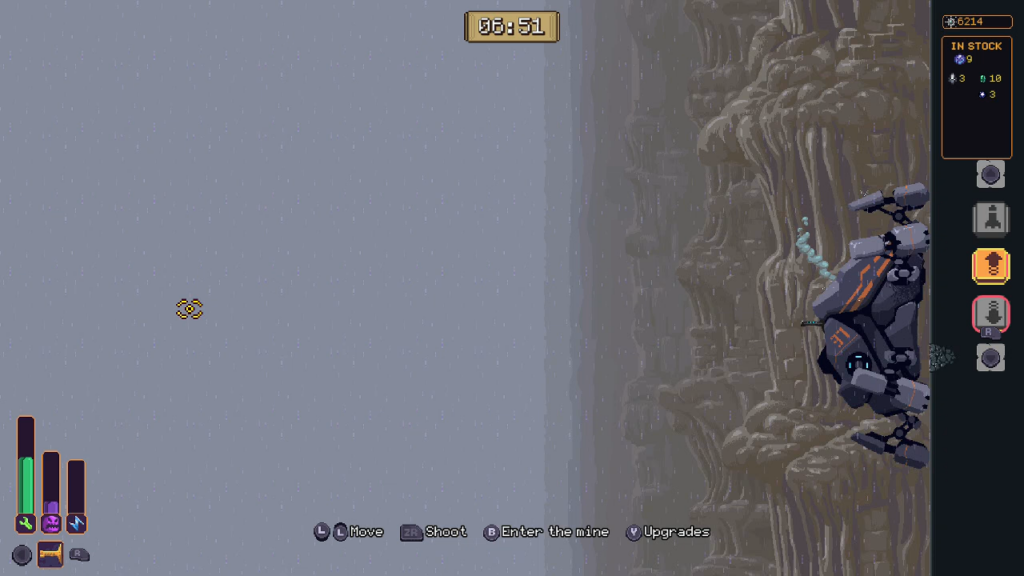
Each biome is different in appearance, separated by a layer of clouds that disguises the transition between backdrops. If the pilot takes their Robospider down from the colonies, they find a plain of flowstone, curtains of calcified rock formed over centuries as water drips down the Wall’s surface. In the opposite direction, the Wall becomes lush with moss and young trees—as well as massive, frozen robotic arms grasping from between cracks, as though their owners were suddenly trapped within the Wall and died while trying to struggle out.
The further up and down the Wall the pilot takes their Robospider, the more strange and alien the biomes become. Each region also transitions through day and night cycles and can be buffeted by snow and rain. It’s a shame the pilot spends so much time inside the mines; the world of the Wall is as gorgeous as it is mysterious.
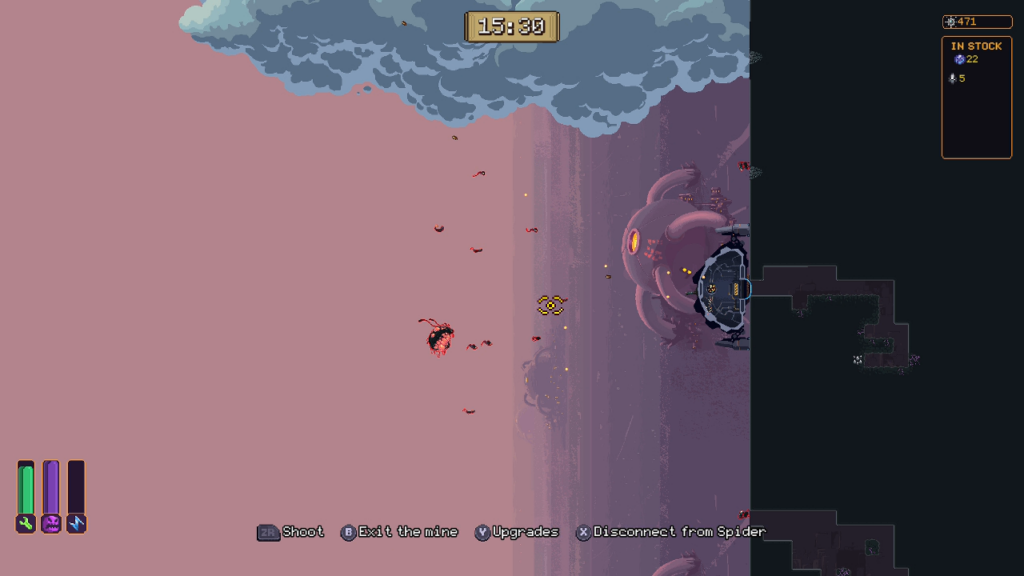
Wherever the pilot travels, a purple meter marked by a scowling monster’s face slowly builds in the screen’s bottom-left corner. When it fills completely, an alarm sounds, heralding a wave of the Zyrex creatures which bedevil all life on the Wall. This meter makes spending time in a mine one of growing tension. An unupgraded Robospider is defenseless when the pilot is not operating it, so getting caught deep in a mine when the Zyrex meter fills can become an automatic game over.
Zyrex come in many varieties that attack both from the surface of the Wall and from the open air out of the screen’s left side. At the start of a run, their attacks are mild. Batlike creatures swoop out of the sky and attack with light projectiles. Diminutive bugs trundle towards the Robospider and attack it with tiny claws when they get in melee range. As time goes on, the Zyrex grow in size and waves increase in length. The bats are soon joined by blobs, pulsating with tumors and tentacles, that plant new melee enemies on the Wall and add their own projectiles to the swarm. The diminutive crawler bugs are joined by much larger ones that hit the Robospider like charging bulls. The situation gets truly dire when exploding jellyfish are added to the mix. Fending off later Zyrex waves requires speed, agility, and precision.
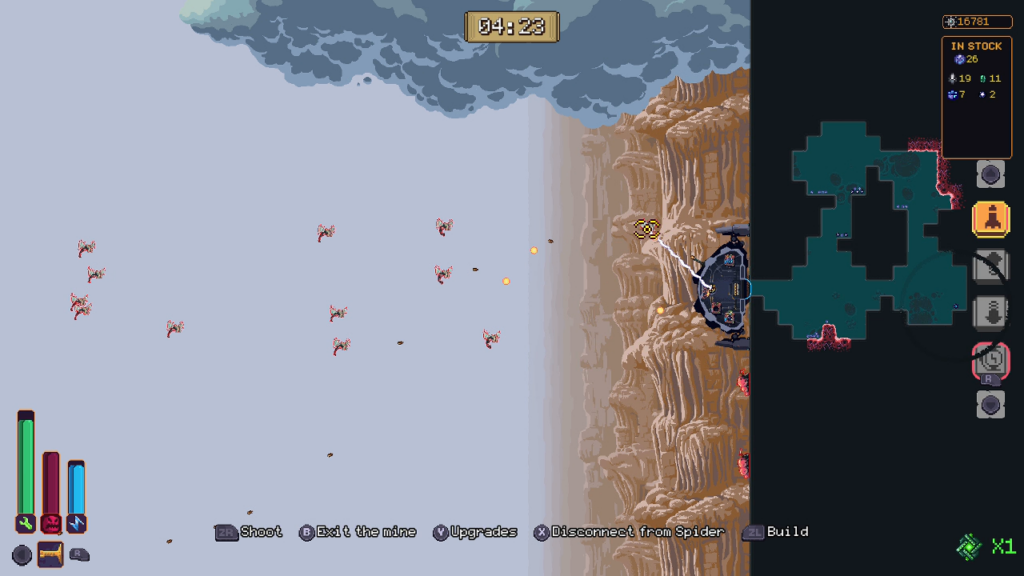
Much of the challenge in fighting the Zyrex comes from how imprecise the Robospider’s weapons can be. Instead of directly controlling the pivoting cannon, I control a targeting cursor which I can point where I want the weapon to fire. Until it is upgraded, the default cannon is inaccurate and rotates much more slowly than the cursor can move. Zyrex are nimble and attack from many directions at once; though I can move the cursor from a cluster attacking the Robospider’s bottom half to another attacking its top half in a fraction of a second, it takes several seconds more for an unupgraded cannon to swivel all the way around to fire at them. The Robospider takes most of its damage during these dire moments. This damage may be repaired, instantly and in the heat of a battle, but at the price of the rare gems needed for the best upgrades.
The purple Zyrex meter is an unobtrusive element of the interface, fitting in beside its neighbor that tracks the Robospider’s remaining health. A more noticeable element is the timer at the top of the screen which ticks down from twenty minutes. When this timer empties, instead of a new wave of Zyrex attacks, the Robospider is assaulted by Wall World’s sole boss.
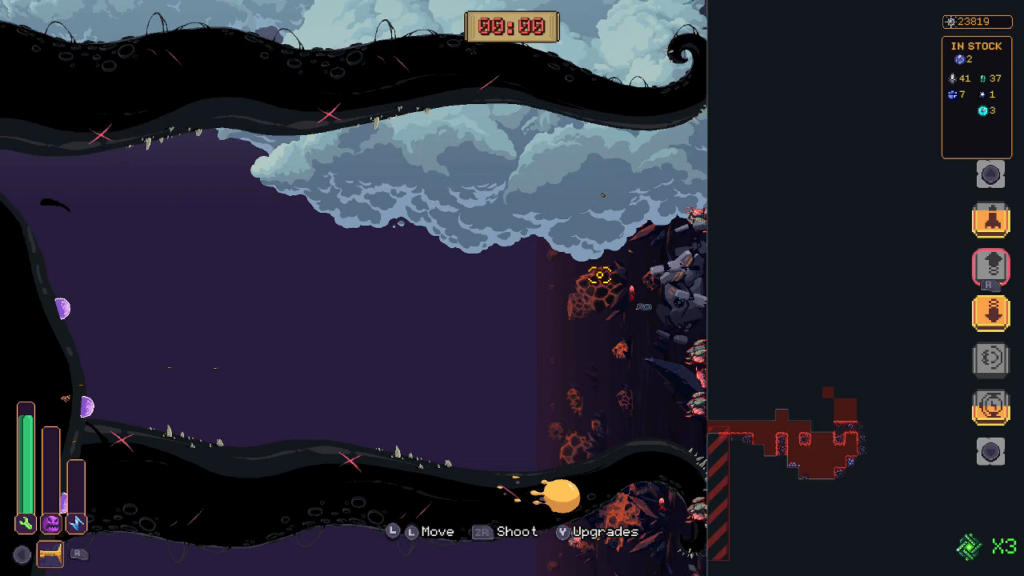
This boss is a colossal Zyrex that lurches out from the empty sky at the screen’s left slide. Using two massive tentacles, it traps the Robospider in a small space of the Wall. It then tries to crush the Robospider with regular thrusts from a third tentacle. These attacks are telegraphed by flashing red highlights on the Wall’s surface. It is not difficult to move the Robospider out of the way of these attacks, but movement is complicated by an endless wave of regular Zyrex that join the colossal Zyrex’s attack. At its most frantic, fighting this boss becomes a matter of defeating it before the Robospider is destroyed by sheer weight of numbers. This is made still more difficult by how the boss’ few weak points are often shielded by the swarm of smaller Zyrex. Without upgrading the cannon’s accuracy, it can be impossible to hit these weakpoints with conventional weapons at all.
The boss attacks the Robospider three times in twenty minute intervals during a normal round. The first fight has a difficulty curve, but I soon learn to take it down reliably. The second fight is a sheer desperate struggle for survival; it is less about ability and more a test of how many upgrades the pilot has been able to purchase before it is encountered. The final twenty minutes of a round following the second encounter are notably easier than the middle twenty minutes. It takes many hours of practice and knowledge of the Wall’s geography to reliably reach this endstage sequence.
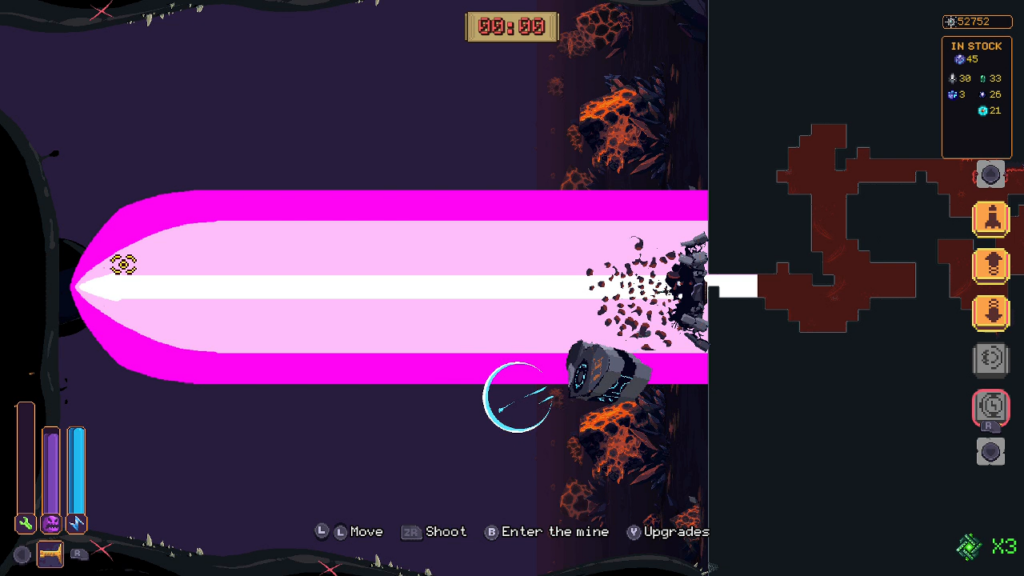
The third encounter with the Zyrex boss is the most interesting one. It simply cannot be defeated. No matter how much the pilot has accomplished, when the sixty minute mark in a round is reached, the boss appears and the Robospider is destroyed.
Another place where Wall World opposes its own stated premise is player character death. Despite the prologue’s assertion that more than half of all Robospider pilots are killed by the Zyrex, my player character is never in any mortal peril. When their Robospider reaches critical health, the pod containing its pilot automatically ejects and rockets them back to their colony at the Wall’s center. They’ve lost their Robospider, its acquired upgrades, and most significantly their gathered resources—their presumed reason for venturing out onto the Wall in the first place—but suffer no physical injury. There’s always another Robospider waiting for them, again in defiance of the alleged resource scarcity the colonies live under, and no expectation from any authority that the pilot will actually return with something useful from their next expedition. This loop repeats endlessly into eternity or until I quit playing.
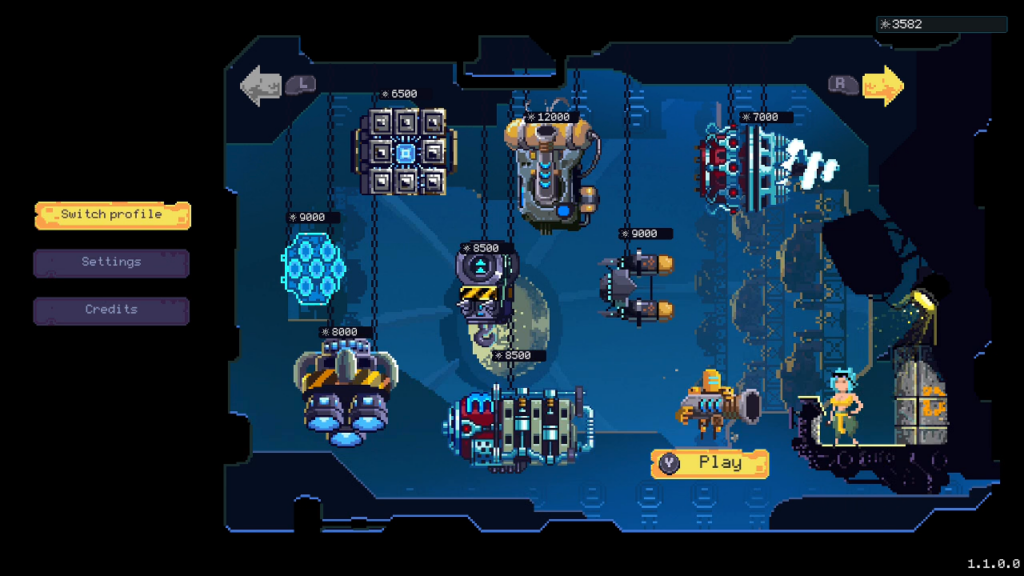
Before the pilot embarks on another expedition, they may invest in new Robospider upgrades. Since the pilot loses their stockpiled gems when their old Robospider is destroyed, these upgrades are purchased with a different currency. Every time the pilot cuts away a square of earth inside a mine, it produces at least one sparkle of light which automatically swirls into the pilot’s Exosuit. These sparkles are the currency upgrades are purchased with at the Robospider workshop between rounds. The more mines the pilot can clear out in a single run, the more of these sparkles they earn to spend on upgrades. Unlike the upgrades purchased with gems during a round, these upgrades affect all future Robospiders the pilot deploys.
These upgrades vary in usefulness. Improving the Robospider’s durability and speed is valuable for obvious reasons. A homing rocket which may be fired at no cost between short cooldowns helps immensely against the most dangerous Zyrex forms, especially the boss. Other upgrades, like boosters which send the Robospider leaping a short distance up or down the Wall, are less useful than they sound.
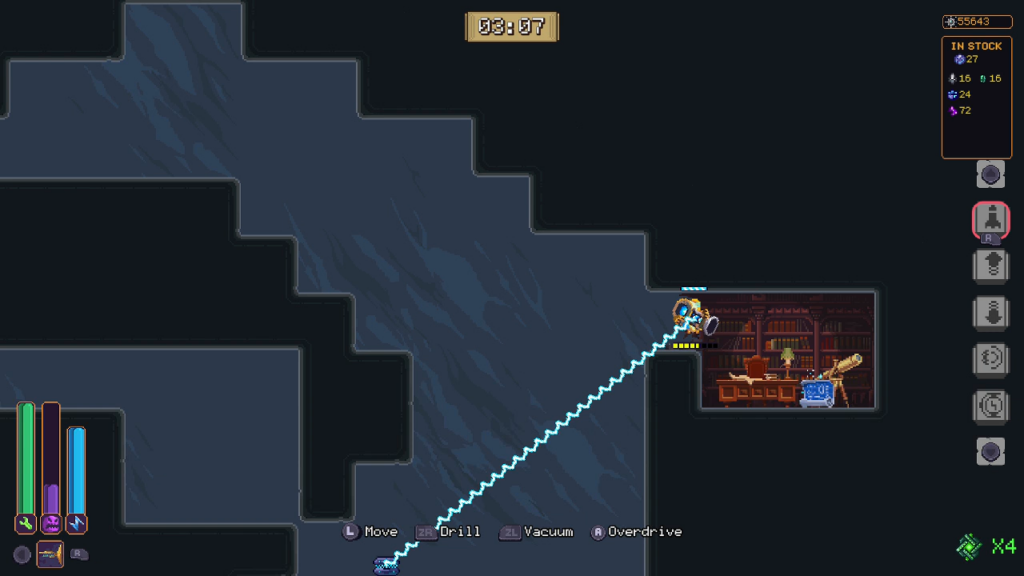
Getting a few of these permanent upgrades goes a long ways towards surviving longer on the Wall, but they are not the most useful upgrades. After I play a few rounds, my pilot begins to discover blueprints in some of the Wall’s further and deeper mines. These add new classified upgrades to the Robospider workshop. A Combat Capacitor fires an arc of electricity through all nearby Zyrex; this can wipe out early waves in a single shot, letting the pilot immediately get back to mining. More transformative than that is a Force Field that absorbs Zyrex attacks and regenerates between waves, cutting down the number of rare gems that must be spent on costly repairs. Finding and purchasing a few classified upgrades takes Wall World’s intimidating early difficulty and completely turns it on its head.
Classified blueprints are not the only things hidden in the Wall’s deepest recesses. In many mines, the pilot discovers ancient relics from a previous civilization. They are found spread all across the Wall, encouraging me to push the pilot to new extremes on each attempt instead of following a safe, familiar path. When all of these relics are collected, I may finally approach Wall World’s endstate.
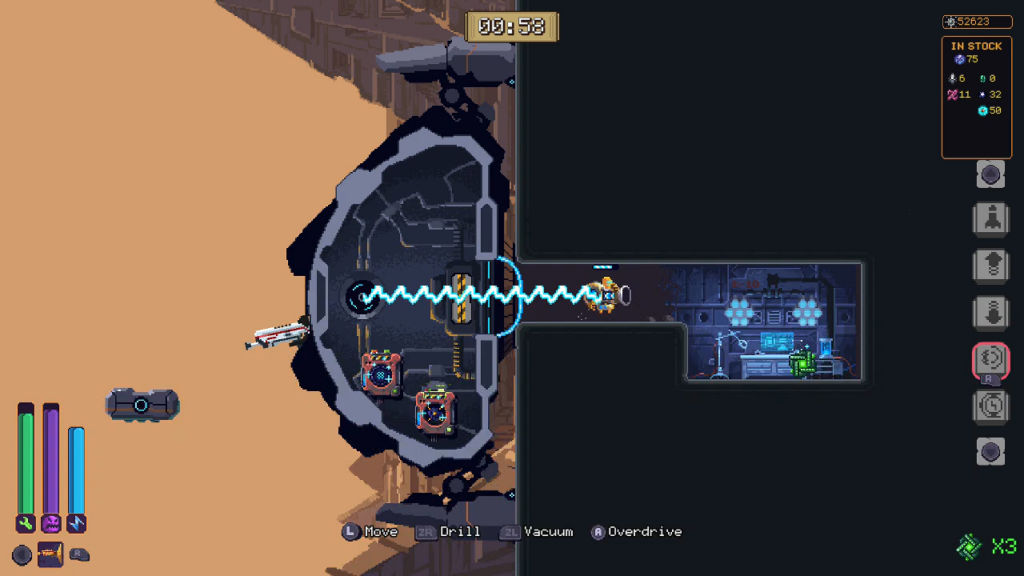
And what an interesting endstate it is: It permanently kills the Zyrex boss. The pilot may continue embarking on new expeditions where they may discover more classified blueprints and fully upgrade the Robospider, but it’s an empty experience with trivial difficulty. The pleasant tedium of fully excavating the Wall is the only reason to keep playing, and I can get that from Minecraft.
Wall World is a great idea that is fumbled by execution. Its premise is fantastic, but it oversells that premise. I am told the Wall is infinite; it is actually small and may be navigated from bottom to top in a couple minutes with a fully upgraded Robospider. I am told the surviving human colonies are supported by the Robospider pilots; my pilot never does any service for their community and seems to exist only to destroy an endless chain of Robospiders. I am told most pilots die in their expeditions; my pilot is never in any mortal peril, able to return to their home at any time using an invincible evacuation pod. I never feel like I am experiencing the world that the prologue describes to me.
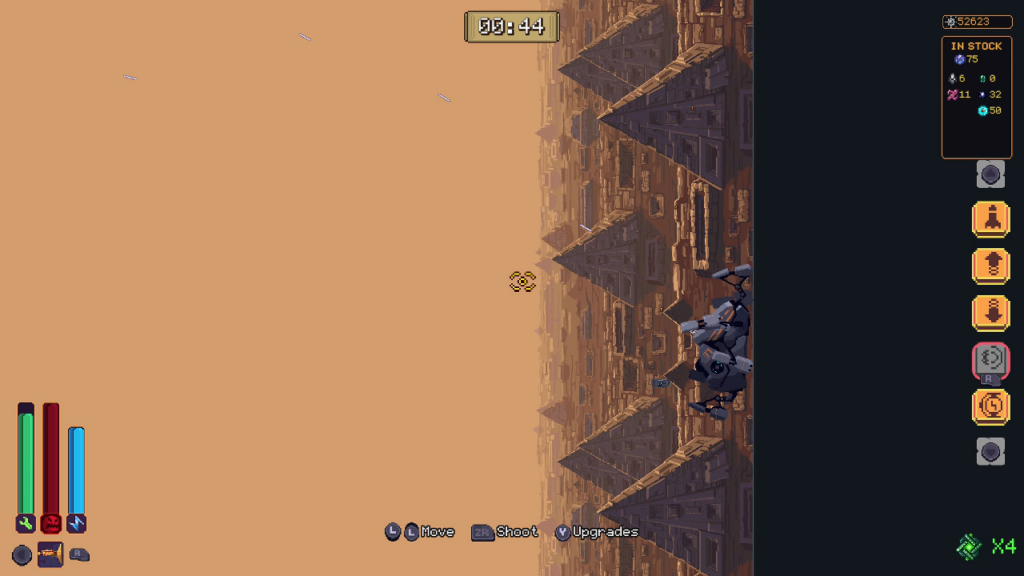
Wall World’s strengths are found in its mechanics. Clearing out a mine, upgrading the Robospider and the pilot’s tools, and then moving to the next mine can be a fascinating and hypnotic experience that is disrupted only by the regular Zyrex attacks. Until a few key upgrades are bought from the workshop, even early attacks can feel dispiritingly insurmountable. The tables are soon turned, and the difficulty reaches the point that the Zyrex boss has been obliterated from existence. Wall World continues past this point, but I’m not sure why. There’s the essence of something greater seeded here, but it needs more care and attention for that seed to sprout.